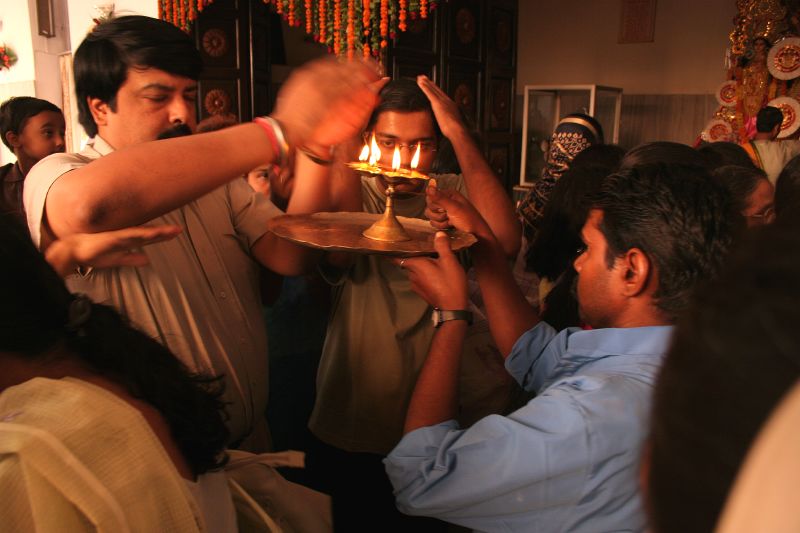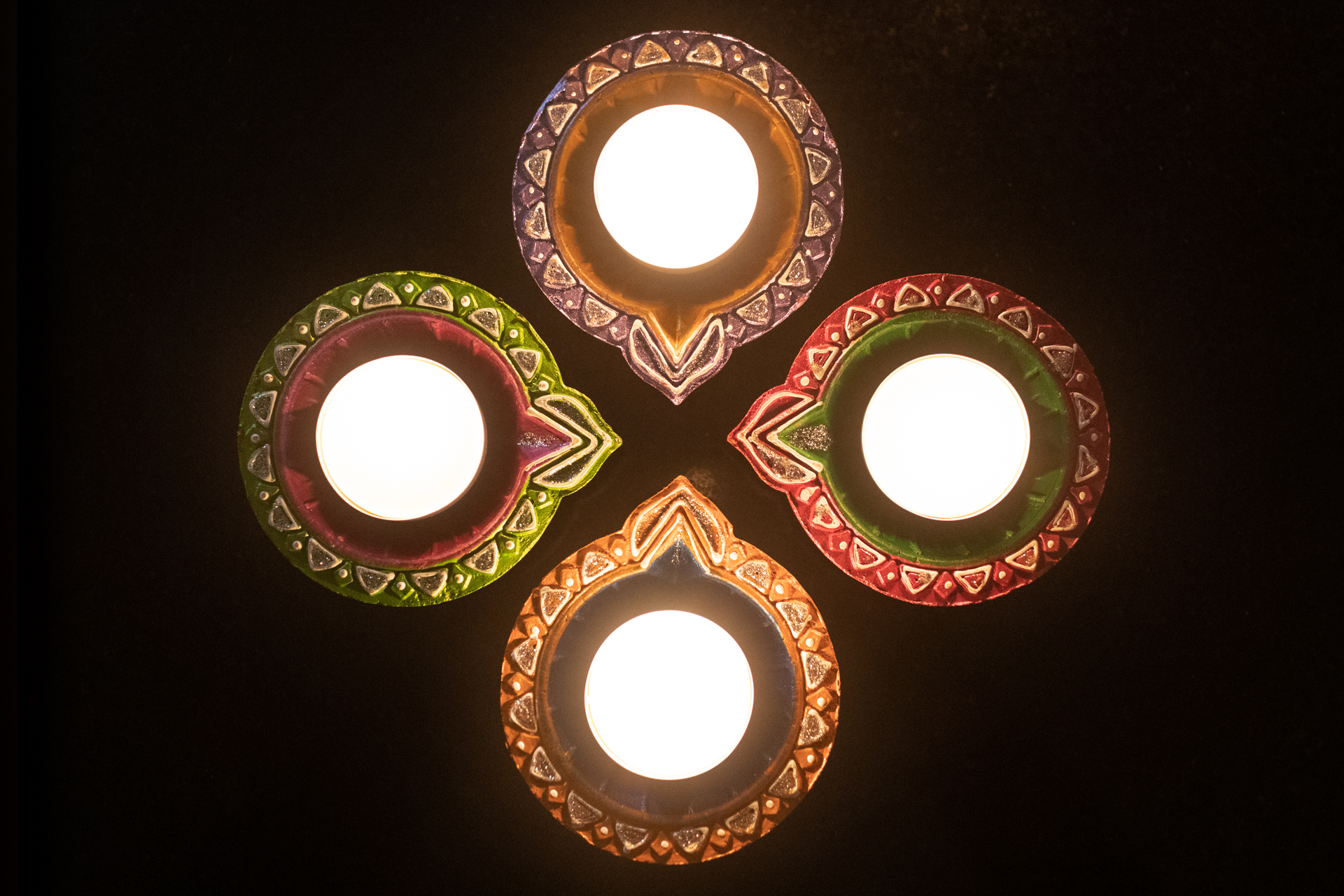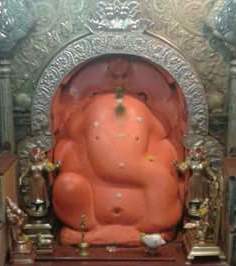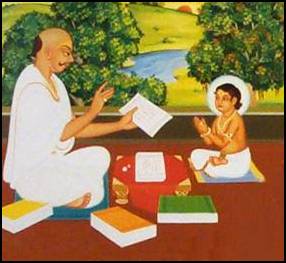|
Aarti
''Arti'' () or ''Aarati'' () is a Hindu ritual employed in worship, part of a ''Puja (Hinduism), puja'', in which light from a flame (fuelled by camphor, ghee, or oil) is ritually waved to venerate Hindu deities, deities. ''Arti'' also refers to the hymns sung in praise of the deity, when the light is being offered. Sikhs have ''Arti'' ''kirtan'' which involves only devotional singing; the Nihang order of Sikhs also use light for ''arti''. Etymology and origin ''Aarti'' is thought to have descended from Historical Vedic religion, ''Vedic'' ''fire rituals or yajna''. ''Aarati'' is derived from the Sanskrit word () which means something that removes , “darkness”.James Lochtefeld, An illustrated Encyclopedia of Hinduism, , page 51 A Marathi language reference says it is also known as (). According to Steven Rosen, ''arti'' means "before night" or symbolic end of the night to the worshipper's "material sojourn - he or she is now situated in the light of God's devotion."Rosen, ... [...More Info...] [...Related Items...] OR: [Wikipedia] [Google] [Baidu] |
Diya (lamp)
A diya, diyo, deya, deeya, dia, divaa, deepa, deepam, deep, deepak or saaki () is an oil lamp made from clay or mud with a cotton wick dipped in oil or ghee. These lamps are commonly used in the Indian subcontinent and they hold sacred prominence in Hindu, Sikh, Buddhist, and Jain prayers as well as religious rituals, ceremonies and festivals including Diwali. Traditional use Diyas are symbolically lit during prayers, rituals, and ceremonies; they are permanent fixtures in homes and temples. The warm, bright glow emitted from a diya is considered auspicious, regarded to represent enlightenment, prosperity, knowledge and wisdom. Diyas represent the triumph of light over dark, good over evil with the most notable example of this being on the day of Diwali. Diwali is celebrated every year to celebrate the triumph of good over evil as told in the Hindu epic, the Ramayana. Diwali marks the day Rama, Sita, and Lakshmana returned home to Ayodhya after 14 years in exile, after the def ... [...More Info...] [...Related Items...] OR: [Wikipedia] [Google] [Baidu] |
Murti
In the Hinduism, Hindu tradition, a ''murti'' (, ) is a devotional image, such as a statue or icon, of a Hindu deities, deity or Hindu saints, saint used during ''Puja (Hinduism), puja'' and/or in other customary forms of actively expressing devotion or reverence – whether at Hindu temples or shrines. A ''mūrti'' is a symbolic icon representing divinity for the purpose of devotional activities. Thus, not all icons of gods and saints are ''mūrti''; for example, purely decorative depictions of divine figures often adorn Hindu temple architecture in intricately carved doorframes, on colourfully painted walls, and ornately sculpted rooftop domes. A ''mūrti'' itself is not God, but it is merely a representative shape, symbolic embodiment, or iconic manifestation of God. ''Murti'' are also found in some nontheistic Jainism, Jain traditions, where they serve as symbols of revered mortals inside Jain temples, and are worshiped in ''murtipujaka'' rituals. A ''murti'' is typically ... [...More Info...] [...Related Items...] OR: [Wikipedia] [Google] [Baidu] |
Sukhakarta Dukhaharta
''Sukhakarta Dukhaharta'' (literally "harbinger of happiness and dispeller of distress", , ), also spelled as ''Sukhkarta Dukhharta'', is a popular Marathi arati, song or bhajan (devotional song) dedicated to the Hindu god Ganesha, composed by the saint Samarth Ramdas (1608 - 1682 CE). It is included in the "most standard and almost universal" aarti songs sung at the start of Puja (worship rituals) of Ganesha in Maharashtra, especially in his festival Ganesh Chaturthi as well as in Ganesha temples in the region. Background Ganesha is the Hindu god of wisdom, knowledge and new beginnings. He is depicted with an elephant head. Samarth Ramadas was inspired to compose the arati by seeing the icon of Mayureshwara (a form of Ganesha) at Morgaon Ganesha Temple, the chief shrine in the Ashtavinayaka pilgrimage circuit, consisting of eight Ganesha temples around Pune. The arati is composed in the raga (musical mode) Jogiya (Jogia). Pratapaditya Pal describes the "addresses and refe ... [...More Info...] [...Related Items...] OR: [Wikipedia] [Google] [Baidu] |
Dhunuchi Nritya
Dhunuchi Nritya or Dhunuchi Naach is a Bengali traditional dance. This devotional dance is performed during Hindu puja and aarti ceremonies in Bengal. The dance is seen performed during Durga Puja by devotees, mainly Bengali Hindus. This dance celebrates Goddess Durga's victory over Mahishasura, which incorporates themes of victory and empowerment. Dance Dhunuchi Nritya is deeply associated with Durga Puja, which is traditionally performed by men. Women are now increasingly taking an active part in traditionally masculine dances. The dance is usually performed during the last days of Durga Puja, especially between ''Ashtami'' and ''Dashami''. Costumes Both men and women usually wear traditional Bengali clothes while performing the Dhunuchi Nritya. The traditional dance-related dress for women is the garad sari, which Bengali Hindu women wear during puja or sacred religious ceremonies. Dhoti The dhoti is an ankle-length breechcloth, wrapped around the waist and the ... [...More Info...] [...Related Items...] OR: [Wikipedia] [Google] [Baidu] |
Puja (Hinduism)
() is a worship ritual performed by Hindus to offer devotional homage and prayer to one or more deities, to host and honour a guest, or to spiritually celebrate an event. It may honour or celebrate the presence of special guests, or their memories after they die. The word ''puja'' is roughly translated into English as 'reverence, honour, homage, adoration, or worship'.पूजा ''Sanskrit Dictionary'', Germany (2009) ''Puja'' (পুজো / পুজা in Bengali language, Bangla), the loving offering of light, flowers, and water or food to the divine, is the essential ritual of Hinduism. For the worshipper, the divine is visible in the image, and the divinity sees the worshipper. The interaction between human and deity, between human and guru, is called a ''Darshan (Indian re ... [...More Info...] [...Related Items...] OR: [Wikipedia] [Google] [Baidu] |
Ghee
Ghee is a type of clarified butter, originating from South Asia. It is commonly used for cooking, as a Traditional medicine of India, traditional medicine, and for Hinduism, Hindu religious rituals. Description Ghee is typically prepared by simmering butter, which is obtained by churning cream, skimming any impurities from the surface, then pouring and retaining the clear liquid fat while discarding the solid residue that settles at the bottom. Spices can be added for flavor. The texture, color, and taste of ghee depend on the quality of the butter, the milk used in the process, and the duration of boiling. Etymology The word ''ghee'' is borrowed from the Hindi word (''ghī''), which comes from (', ) 'clarified butter', from the root , , 'to sprinkle'; it is cognate with the Ancient Greek word (, 'rubbed, anointed'), from which the English word ''Christ'' is derived. In Hinduism Traditionally, ghee is made from bovine milk, either Cattle, cow or water buffalo, and has ... [...More Info...] [...Related Items...] OR: [Wikipedia] [Google] [Baidu] |
Swaminarayan
Swaminarayan (IAST: '; 3 April 1781 – 1 June 1830), also known as Sahajanand Swami, was a yogi and Asceticism, ascetic believed by followers to be a manifestation of Krishna or the highest Theophany, manifestation of Purushottama, around whom the Swaminarayan Sampradaya developed. In 1800, he was initiated into the ''Uddhava'' ''sampradaya'' by his guru, Swami Ramanand, and was given the name Sahajanand Swami. Despite opposition, in 1802, Ramanand handed over the leadership of the Uddhava Sampradaya to him before his death. According to the Swaminarayan tradition, Sahajanand Swami became known as Swaminarayan, and the Uddhava Sampradaya became known as the Swaminarayan Sampradaya, after a gathering in which he taught the Swaminarayan Mantra to his followers. He emphasized "moral, personal, and social betterment," and ''ahimsa''. He is also remembered within the sect for undertaking reforms for women and the poor, and performing large-scale non-violent yajna, yajñas (fire s ... [...More Info...] [...Related Items...] OR: [Wikipedia] [Google] [Baidu] |
Jai Jagdish Hare
Om Jai Jagdish Hare () is a Hindu religious song written by Shardha Ram Phillauri. It is a Hindi-language composition dedicated to the deity Vishnu, popularly sung during the ritual of '' arti''. It has been described as a "film ''arti''" due to its inclusion in the film ''Purab Aur Paschim'' (1970), after which it became immensely popular such that it entered temple ''puja''s. Due to its popularisation by Bollywood cinema, it has been described as a "national ''arti''" that is sung on any given religious occasion. In the late 1980s, it was associated with younger educated people whose notions of religious ritual had had greater influence from Hindi cinema than local religious tradition. Popular culture * In the 1952 movie, Anand Math, the Govinda damodar Stotram of Sri BilvaMangala Thakura is adapted with the Jai Jagdish Hare refrainvideo search * In Purab Aur Paschim (1970), the prayer symbolizes the continuity of the Indian tradition before and after India's independencevi ... [...More Info...] [...Related Items...] OR: [Wikipedia] [Google] [Baidu] |
Ganesha
Ganesha or Ganesh (, , ), also known as Ganapati, Vinayaka and Pillaiyar, is one of the best-known and most worshipped Deva (Hinduism), deities in the Hindu deities, Hindu pantheon and is the Supreme God in the Ganapatya sect. His depictions are found throughout India. Hindu denominations worship him regardless of affiliations. Devotion to Ganesha is widely diffused and extends Ganesha in world religions, to Jains and Buddhists and beyond India. Although Ganesha has many attributes, he is readily identified by his Asiatic Elephant, elephant head and four arms. He is widely revered, more specifically, as the remover of obstacles and bringer of good luck; the patron of The arts, arts and Science, sciences; and the Deva (Hinduism), deva of intellect and wisdom. As the god of beginnings, he is honoured at the start of rites and ceremonies. Ganesha is also invoked during writing sessions as a patron of letters and learning., Vigna means obstacles Nasha means destroy. These ideas ar ... [...More Info...] [...Related Items...] OR: [Wikipedia] [Google] [Baidu] |
Pushtimarg
The Puṣṭimārga, also known as Pushtimarg (Path of Nourishing or Flourishing) or Vallabha Sampradāya, is a Hindu Vaiṣṇava saṁpradāya. It was established in the early 16th century by Vallabha (1479–1530) and further developed by his descendants, particularly his son Viṭṭhalanātha. Followers of the Puṣṭimārga worship Kr̥ṣṇa and engage in devotional practices centered around the youthful Kr̥ṣṇa as depicted in the ''Bhāgavata Purāṇa'', and the pastimes at Govardhan Hill. The Puṣṭimārga sect follows the Śuddhadvaita philosophy of Vallabha. According to this philosophy, Kr̥ṣṇa is considered the supreme deity and the source of everything. The human soul is believed to be imbued with Kr̥ṣṇa's divine light, and spiritual liberation is thought to result from Kr̥ṣṇa's grace. The sect worships Kr̥ṣṇa through ''sevā'', a practice in which his idols are served and entertained with food, drink, music, and art, recreating his ... [...More Info...] [...Related Items...] OR: [Wikipedia] [Google] [Baidu] |
Jay Sadguru Swami
Jay Sadguru Swami is the Aarti, arti sung at Swaminarayan Sampraday, Swaminarayan Sampradaya mandirs. This arti was composed by Muktanand Swami on 5 November 1802. During the arti, a lighted lamp is waved before murtis, representations of Swaminarayan and other deities. In Shikharband Mandir, shikharbaddha mandirs, arti is performed five times a day; in Dev Mandir, dev mandirs, also known as Hari mandirs, arti is performed in the morning and evening only. See also * Swaminarayan * Swaminarayan Sampradaya References Hindu music Swaminarayan Sampradaya Aarti {{Hinduism-stub ... [...More Info...] [...Related Items...] OR: [Wikipedia] [Google] [Baidu] |
Ganges
The Ganges ( ; in India: Ganga, ; in Bangladesh: Padma, ). "The Ganges Basin, known in India as the Ganga and in Bangladesh as the Padma, is an international which goes through India, Bangladesh, Nepal and China." is a trans-boundary river of Asia which flows through India and Bangladesh. The river rises in the western Himalayas in the States and union territories of India, Indian state of Uttarakhand. It flows south and east through the Gangetic Plain, Gangetic plain of North India, receiving the right-bank tributary, the Yamuna, which also rises in the western Indian Himalayas, and several left-bank tributaries from Nepal that account for the bulk of its flow. In West Bengal state, India, a feeder canal taking off from its right bank diverts 50% of its flow southwards, artificially connecting it to the Hooghly River. The Ganges continues into Bangladesh, its name changing to the Padma River, Padma. It is then joined by the Jamuna River (Bangladesh), Jamuna, the lower str ... [...More Info...] [...Related Items...] OR: [Wikipedia] [Google] [Baidu] |










